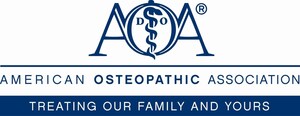CHICAGO, June 12, 2018 /PRNewswire-USNewswire/ -- Shingles vaccination is now nearly twice as effective as the previous protocol and available to patients 10 years younger than before, enabling largescale prevention of a painful, common condition. Adoption of the new standard of care could vastly reduce the one million annual cases of the disease, according to osteopathic physicians.
Almost one in three Americans will be afflicted with shingles in their lifetime.i Shingles is a painful potentially debilitating illness that is only preventable through vaccination according to the CDC. In 2016, researchers found only 33 percent of eligible patients were vaccinated, pointing to the limited efficacy of the previous vaccine, a lack of awareness that the illness can be prevented and cost concerns.ii
A new survey commissioned by the American Osteopathic Association finds less than two-thirds of Americans (62%) are aware that there is a shingles vaccine. The online survey was conducted by The Harris Poll in June 2018 on behalf of the AOA.
"This is an unprecedented opportunity to nearly eliminate shingles among our patient population, as well as the possibility of chronic pain or even blindness that can accompany the condition," says Judith Lightfoot, DO, an infectious disease specialist at Rowan University School of Osteopathic Medicine. "It's a prevention conversation I'm having with nearly every patient over fifty."
The new vaccine, marketed as Shingrix, is shown to be 97 percent effective in adults ages 50-69,iii and more than 90 percent effective in those 70 to well past 80. The earlier vaccine, Zostavax, prevented just over half (51%) of recipients from developing the painful disease and was recommended for patients 60 and older, due to waning immunity over time.
Prevention is simple and safe
Shingles occurs when the herpes zoster virus—the same virus that causes chickenpox—reactivates years or decades later. Patients may not recall if they've had chicken pox in the past or received a previous vaccination, but Dr. Lightfoot notes that if patients are unable to verify which vaccines they have received, there is little to no harm in receiving the new vaccine—in fact, it's recommended.
Benefits of the new vaccine include:
- Immunity at a younger age. Vaccination is now recommended for adults over 50 rather than 60, a result of extended effectiveness.
- May be offered to some patients who have a compromised immune system, including cancer patients who are prone to developing the disease.
- Even after an outbreak, the new vaccination can prevent a recurrence.
"Vaccinations prime the immune system for attack, so you are ready to repel an infection or flare-up," says Dr. Lightfoot, "The physical and emotional comfort of knowing you are immune to the disease far outweighs the limited discomfort related the two recommended shots."
Potential side effects include injection site redness and swelling, muscle pain, and immune system responses such as headache, shivering, fever and upset stomach.
Blistering skin eruption, searing pain
The pain associated with herpes-zoster can be intense and debilitating. For about 10 to 13 percent of people, shingles leaves them with deep, searing nerve pain — a condition called post-herpetic neuralgia, or PHN — that can last for months or years and has no treatment or cure. More than half the cases of PHN affect people over 60. Other possible complications of shingles include pneumonia, hearing problems, blindness, encephalitis and very rarely death.
Shingles gets its name from both Latin and French words for belt, or girdle, because of the girdle-like skin eruptions that occur on the mid-section of the body. For most people, symptoms emerge as a painful rash that develops on one side of the face or body followed by blisters that typically scab over in seven to 10 days. The rash usually clears up within two to four weeks.
People often experience pain, itching, or tingling in the area before the rash develops, which may happen anywhere from one to five days before the rash appears.
About the AOA
The American Osteopathic Association (AOA) represents more than 137,000 osteopathic physicians (DOs) and osteopathic medical students; promotes public health; encourages scientific research; serves as the primary certifying body for DOs; and is the accrediting agency for osteopathic medical schools.
To learn more about DOs and the osteopathic philosophy of medicine, visit www.DoctorsThatDo.org.
Survey Methodology
This survey was conducted online within the United States by The Harris Poll on behalf of AOA from June 1-5, 2018 among 2,041 U.S. adults ages 18 and older. This online survey is not based on a probability sample and therefore no estimate of theoretical sampling error can be calculated. For complete survey methodology, including weighting variables and subgroup sample sizes, please contact Jessica Bardoulas.
i https://www.vaccines.gov/diseases/shingles/index.html
ii https://www.cdc.gov/shingles/surveillance.html
iii https://www.nejm.org/doi/full/10.1056/NEJMoa1603800#t=article
SOURCE American Osteopathic Association
Related Links
WANT YOUR COMPANY'S NEWS FEATURED ON PRNEWSWIRE.COM?
Newsrooms &
Influencers
Digital Media
Outlets
Journalists
Opted In






Share this article